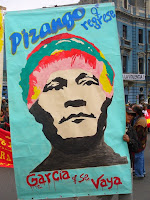
On the 28th itself, Independence Day, we headed off to the nearby village of Muyurina for lunch and to watch a corrida bufa, a bullfight in which the bullfighters dress in comic outfits and put on a degree of slapstick in the ring.
One of the characters that always is portrayed is that of the Negra Tomasa. For this the bullfighter dons blackface and an Aunt Jemima-like outfit of dress and head scarf or cap. Usually the outfit includes large breasts and buttocks made with balloons. The character doesn't particularly act "black" but is usually sassy and plays up the "attributes" when facing the bull.
For some reason, the accompanying characters always seem to be drawn from the popular Mexican TV comedy El Chavo del Ocho, with the characters of Chavo, Quico, and Chilindrina being the usual ones portrayed. In this instance, we got Chilindrina, although they brought along Chavo's barrell.
The bulls -actually five bullocks and one cow- had supposedly been brought from Rasuwillca, but seemed like they had been simply pulled in from the fields. They lacked the aggressiveness of true toros de lidia, which was, of course a good thing and expected. However, the makeshift bullring proved unable to keep in the animals, a good number of whom managed to force their way out and back to the herd.
There was, nontheless, some excitement in the ring that afternoon, with the band adding the necessary taurine ambience to the event.
The highlight for us came late in the afternoon when we managed to cajole Nicolas into jumping into the action, much to Susana's distress:
One of the characters that always is portrayed is that of the Negra Tomasa. For this the bullfighter dons blackface and an Aunt Jemima-like outfit of dress and head scarf or cap. Usually the outfit includes large breasts and buttocks made with balloons. The character doesn't particularly act "black" but is usually sassy and plays up the "attributes" when facing the bull.
For some reason, the accompanying characters always seem to be drawn from the popular Mexican TV comedy El Chavo del Ocho, with the characters of Chavo, Quico, and Chilindrina being the usual ones portrayed. In this instance, we got Chilindrina, although they brought along Chavo's barrell.
The bulls -actually five bullocks and one cow- had supposedly been brought from Rasuwillca, but seemed like they had been simply pulled in from the fields. They lacked the aggressiveness of true toros de lidia, which was, of course a good thing and expected. However, the makeshift bullring proved unable to keep in the animals, a good number of whom managed to force their way out and back to the herd.
There was, nontheless, some excitement in the ring that afternoon, with the band adding the necessary taurine ambience to the event.
The highlight for us came late in the afternoon when we managed to cajole Nicolas into jumping into the action, much to Susana's distress:






















































